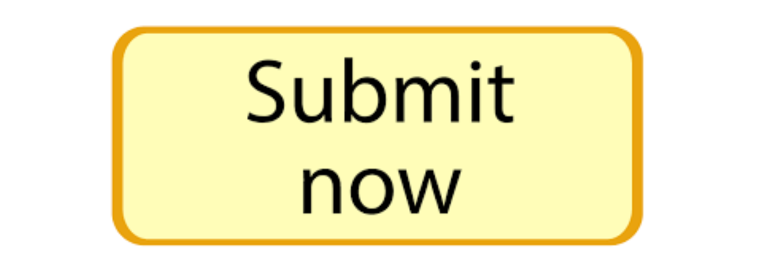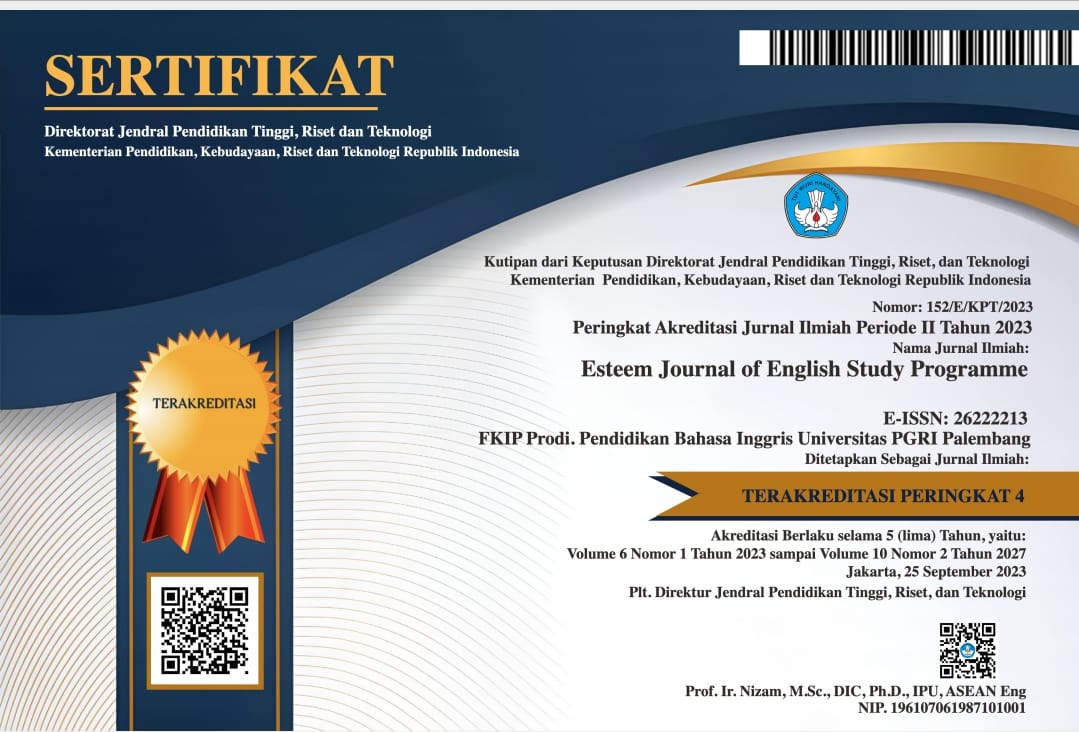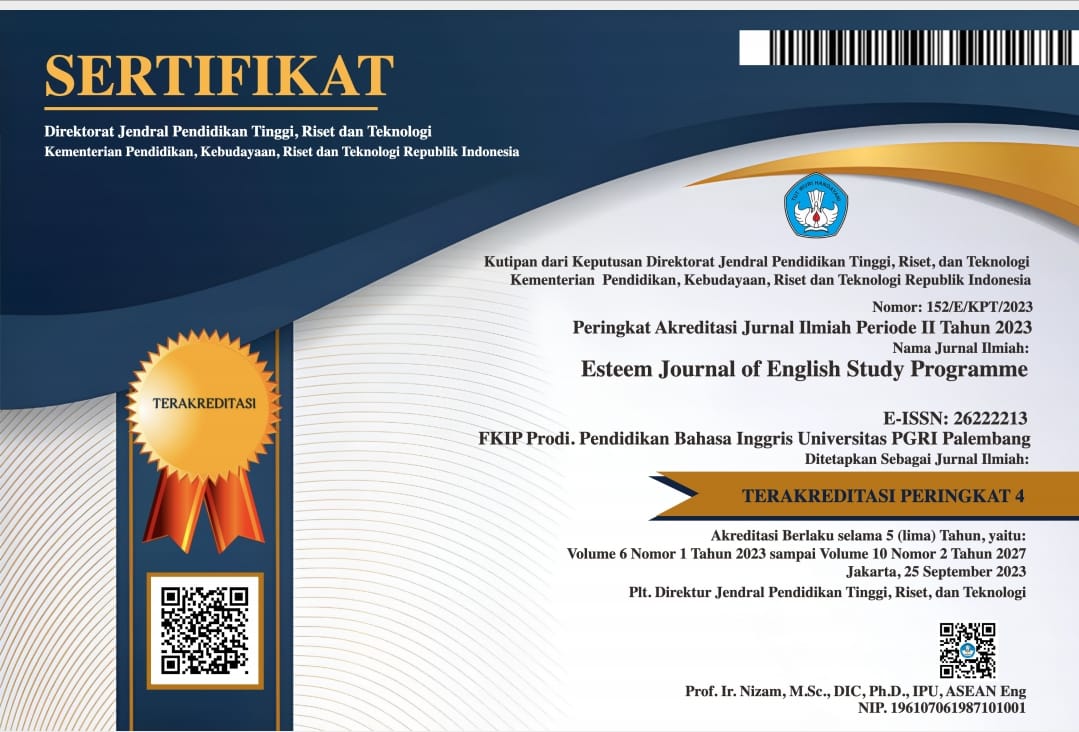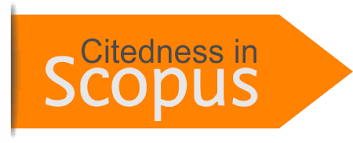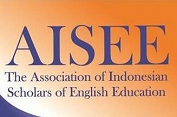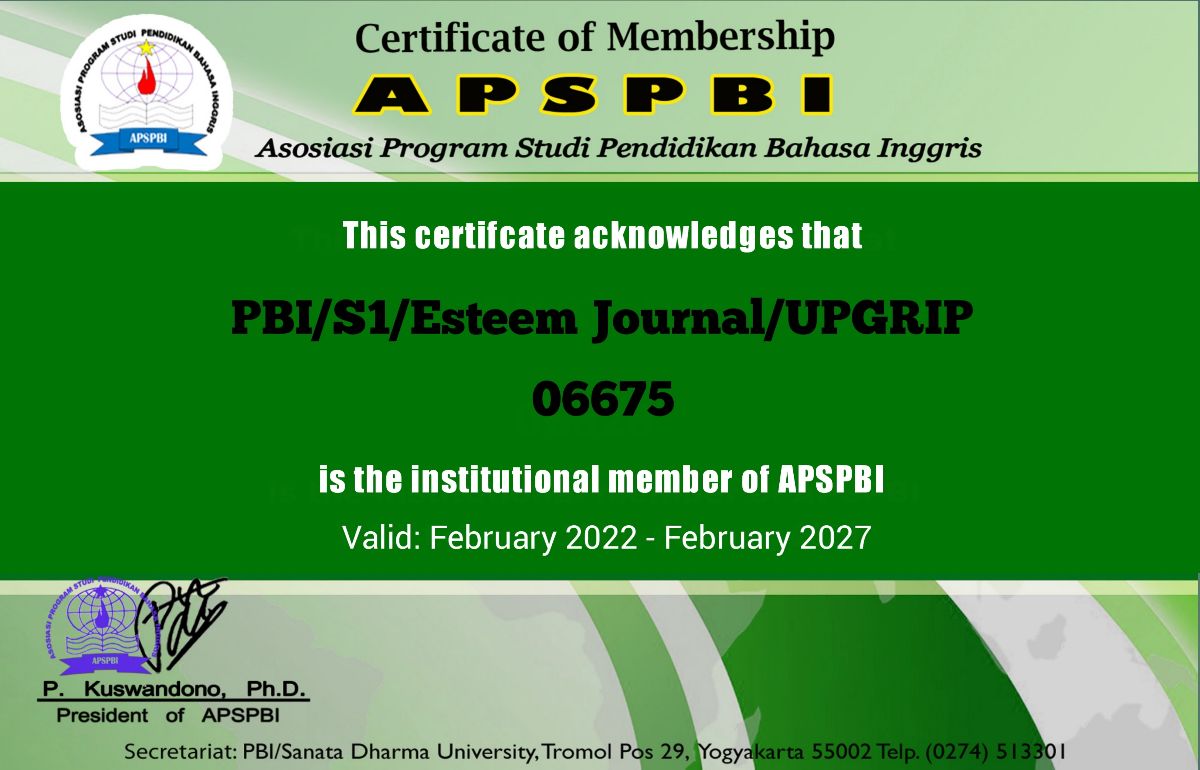TEACHING SPEAKING BY USING 'ELSA AI' TO THE EIGHTH GRADE STUDENTS OF SMP NEGERI 42 PALEMBANG
DOI:
https://doi.org/10.31851/esteem.v8i1.17085Keywords:
Teaching, Speaking, ELSA AIAbstract
This study investigates the effectiveness of the ELSA Speak application in enhancing English speaking skills among eighth-grade students at SMP Negeri 42 Palembang. Employing a quantitative method with a quasi-experimental design (one-group pre-test and post-test design), the research involved 34 students. The instruments used included a pre-test, treatment, and post-test. The results indicate that using ELSA Speak effectively improves English pronunciation skills compared to traditional learning methods. The average pre-test score of the students was 64.9118, which increased to 85.5882 in the post-test, showing an improvement of 31.82%. Hypothesis testing revealed a significance value of 0.000, indicating a significant effect of using ELSA Speak on students' performance improvement. The Cohen's Kappa value of 0.809 demonstrates excellent inter-rater reliability, which positively supports the validity of the obtained results. Future research should examine the long-term effects of ELSA Speak on fluency and confidence, compare it with other language learning tools, and involve larger, more diverse samples for broader insights.
References
Azamatova, A., Bekeyeva, N., Zhaxylikova, K., Sarbassova, A., & Ilyassova, N. (2023). The Effect of Using Artificial Intelligence and Digital Learning Tools based on Project-Based Learning Approach in Foreign Language Teaching on Students’ Success and Motivation. International Journal of Education in Mathematics, Science and Technology, 11(6), 1458–1475. https://doi.org/10.46328/ijemst.3712
Brown, G., & Yule, G. (2004). Teaching the spoken language: An approach based on the analysis of conversational English. Cambridge University Press.
Brown, .D. (2000). Principles of Language Learning and Teaching. Longman.
Chapelle, C. (2001). Computer Applications in Second Language Acquisition: Foundations for Teaching, Testing, and Research. Cambridge University Press.
Creswell, J. W., & Creswell, J. D. (2018). Research Design: Qualitative, Quantitative, and Mixed Methods Approaches. SAGE Publications
Dash, B. B. (2022). Digital Tools for Teaching and Learning English Language in 21 st Century. International Journal Of English and Studies, 4(2), 8–13. http://dx.doi.org/10.47311/IJOES.2022.4202
Dornyei, Z. (2001). Motivational Strategies in the Language Classroom. Cambridge University Press.
Elder, C., & Iwashita, N. (2020). "Assessing speaking in a second language: The role of the task and the rating scale." Language Testing.
Godwin-Jones, R. (2010). Emerging Technologies. Language Learning and Tecnology, 14(2), 4–11. http://llt.msu.edu/vol14num2/emerging.pdf
Harmer, J. (2001). How to teach English.
Hien, N. T. T., & Phuong, V. T. (2023). The effectiveness of the storytelling technique on students’ achievement and motivation in English speaking skills. Multidisciplinary Reviews, 6(Special Issue). https://doi.org/10.31893/multirev.2023spe011
Jaya, A., Hermansyah, & Rosmiyati, E. (2019). Redefining Project Based Learning In English Class. Esteem Journal of English Education Study Programme, 2(https://jurnal.univpgri-palembang.ac.id/index.php/esteem/issue/view/304). https://doi.org/https://doi.org/10.31851/esteem.v2i2.2423
Khanh, C. G. (2021). The Effect of ICT on Learners’ Speaking Skills Development. International Journal of TESOL & Education, 1(1), 22–29.
Kuddus, K. (2022). Artificial Intelligence in Language Learning: Practices and Prospects. Advanced Analytics and Deep Learning Models. https://doi.org/https://doi.org/10.1002/9781119792437.ch1
López-García, P., & Pérez-Moreno, M. A. (2020). "Inter-rater reliability of the Kappa statistic: a systematic review." Frontiers in Psychology, 11, 569.
Nunan, D. (2004). Task-based Language Teaching. Cambridge University Press.
Nunan, D. (2005). Practical English Language Teaching: Young Learners. McGraw-Hill.
Pokrivcakova, S. (2019). Preparing teachers for the application of AI-powered technologies in foreign language education. Journal of Language and Cultural Education, 7(3), 135–153. https://doi.org/10.2478/jolace-2019-0025
Richards, J. C., & Rodgers, T. S. (2014). Approaches and Methods in Language Teaching (3rd Editio). Cambridge University Press.
Spratt, M., Pulverness, A., & Williams, S. (2011). The teaching of English as a Foreign Language (3rd ed.). Routledge.
Sujiati, R., Jaya, A., Rosmiyati, E., & Noviati. (2023). Efl Teachers’ Attitudes and Experiences on the Implementation of Multiliteracies. Esteem Journal of English Education Study Programme, 7(1), 85–96. https://doi.org/10.31851/esteem.v7i1.12653
Wahyuni, S., Mujiyanto, J., Rukmini, D., & Fitriati, S. W. (2019). Examining Teachers’ Innovation in EFL Classrooms in Promoting Students’ Autonomous Learning. International Conference on English Language Teaching, Literature, and Translation, 188, 330–339. https://doi.org/10.2991/eltlt-18.2019.64
Warschauer, M., & Meskill, C. (2000). Technology and Second Language Learning (1st ed.). Routledge.
Yang, H., & Kyun, S. (2022). The current research trend of artificial intelligence in language learning: A systematic empirical literature review from an activity theory perspective. Australasian Journal of Educational Technology, 38(5), 180–210. https://doi.org/10.14742/ajet.7492
Yousefabadi, M. M., Ghasemnezhad, T., & Akbarie, Y. (2022). The Effect of Anxiety, Motivation and Self-Confidence in Language Learners’ Reading Proficiency. NeuroQuantology, 20(16), 4966–4976. https://doi.org/10.48047/NQ.2022.20.16.NQ880504
Downloads
Published
Issue
Section
License
Copyright (c) 2025 Dinda Salsabilla, Tahrun, Evi Rosmiyati

This work is licensed under a Creative Commons Attribution-NonCommercial-ShareAlike 4.0 International License.
Copyright Notice
Authors who publish with this journal agree to the following terms:
In order to assure the highest standards for published articles, a peer review policy is applied. In pursue of the compliance with academic standards, all parties involved in the publishing process (the authors, the editors and the editorial board and the reviewers) agree to meet the responsibilities stated below in accordance to the Journal publication ethics and malpractice statement.
Duties of Authors:
- The author(s) warrant that the submitted article is an original work, which has not been previously published, and that they have obtained an agreement from any co-author(s) prior to the manuscript’s submission;
- The author(s) should not submit articles describing essentially the same research to more than one journal;
- The authors(s) make certain that the manuscript meets the terms of the Manuscript Submission Guideline regarding appropriate academic citation and that no copyright infringement occurs;
- The authors(s) should inform the editors about any conflict of interests and report any errors they subsequently, discover in their manuscript.
Duties of Editors and the Editorial Board:
- The editors, together with the editorial board, are responsible for deciding upon the publication or rejection of the submitted manuscripts based only on their originality, significance, and relevance to the domains of the journal;
- The editors evaluate the manuscripts compliance with academic criteria, the domains of the journal and the guidelines;
- The editors must at all times respect the confidentiality of any information pertaining to the submitted manuscripts;
- The editors assign the review of each manuscript to two reviewers chosen according to their domains of expertise. The editors must take into account any conflict of interest reported by the authors and the reviewers.
- The editors must ensure that the comments and recommendations of the reviewers are sent to the author(s) in due time and that the manuscripts are returned to the editors, who take the final decision to publish them or not.
Authors are permitted and encouraged to post online a pre-publication manuscript (but not the Publisher final formatted PDF version of the Work) in institutional repositories or on their Websites prior to and during the submission process, as it can lead to productive exchanges, as well as earlier and greater citation of published work (see The Effect of Open Access). Any such posting made before acceptance and publication of the Work shall be updated upon publication to include a reference to the Publisher-assigned DOI (Digital Object Identifier) and a link to the online abstract for the final published Work in the Journal.




